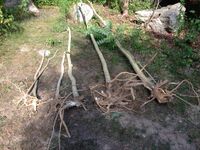Tree of Heaven: Difference between revisions
Watlington (talk | contribs) m (Added links to CISMA and NISIC) |
Watlington (talk | contribs) (Added new info about Spotted Lanterflies and Tree of Heaven) |
||
| Line 17: | Line 17: | ||
[[File:Rhus vs Ailanthus altissima folia UGA-5451741.jpg|thumb|Leaves of Tree of Heaven (bottom) versus Sumac (top)]] | [[File:Rhus vs Ailanthus altissima folia UGA-5451741.jpg|thumb|Leaves of Tree of Heaven (bottom) versus Sumac (top)]] | ||
'''Black Walnut''' (''Juglans Nigra'', [[wikipedia:Juglans_nigra|Wikipedia]], [https://plants.usda.gov/home/plantProfile?symbol=juni USDA], [https://gobotany.nativeplanttrust.org/species/juglans/nigra/ GoBotany]) also has a similar compound leaf. The difference is that the Black Walnut leaves don't have the notch and "eye" at the base, and have teeth along the edge. | '''Black Walnut''' (''Juglans Nigra'', [[wikipedia:Juglans_nigra|Wikipedia]], [https://plants.usda.gov/home/plantProfile?symbol=juni USDA], [https://gobotany.nativeplanttrust.org/species/juglans/nigra/ GoBotany]) also has a similar compound leaf. The difference is that the Black Walnut leaves don't have the notch and "eye" at the base, and have teeth along the edge. | ||
== Other Info == | |||
Recent studies indicate that Tree of Heaven may be contributing to the Spotted Lanterfly infestion in North America. When Spotted Lanterflies feed on Tree of Heaven (their preferred food plant), they concentrate a toxin from Tree of Heaven and become toxic to birds. If their diet does not contain Tree of Heaven, birds learn to eat them and help control them. [https://www.washingtonpost.com/climate-environment/2024/03/04/spotted-lantern-flies-how-to-stop/<nowiki>]</nowiki> | |||
Revision as of 14:22, 6 March 2024
Ailanthus altissima [ CISMA, Wikipedia, USDA - NISIC, GoBotany, IPANE, USFS Weed of the Week! ]
Tree of Heaven is a rapidly growing medium sized tree, up to 80ft. in height. It has large compound leaves, which resemble those of sumac but have a distinctive notch and an "eye" (gland) on each side at the base of the leaf. All parts of the tree smell like peanut butter.


It spreads by seed and also aggressively by root rhizome. It produces toxins which prevent the establishment of other species.
Removal
Larger trees should be girded. If cut, the root system will respond vigorously, by both sprouting at the stump and by sending up saplings from rhyzomes. After removal, expect an overwhelming surge in Tree of Heaven saplings in the area, and both the seed bank and the rhizome system react to the increased light. Repeated years of pulling will be needed to clear the area.

Smaller saplings should be pulled, with as much of the root structure as can be found.
Common Mis-identifications
Most natives which might be confused with Tree of Heaven have teeth along leaf edges:
Smooth Sumac (Rhus Glabra, Wikipedia, USDA, GoBotany) and Staghorn Sumac (Rhus typhina, Wikipedia, USDA, GoBotany) have a compound leaf and juvenile growth form similar to Tree of Heaven. The difference is in the leaf detail (Sumac leaves are smooth at the base, and have teeth along the edges) and smell (Sumac does NOT smell like peanut butter).

Black Walnut (Juglans Nigra, Wikipedia, USDA, GoBotany) also has a similar compound leaf. The difference is that the Black Walnut leaves don't have the notch and "eye" at the base, and have teeth along the edge.
Other Info
Recent studies indicate that Tree of Heaven may be contributing to the Spotted Lanterfly infestion in North America. When Spotted Lanterflies feed on Tree of Heaven (their preferred food plant), they concentrate a toxin from Tree of Heaven and become toxic to birds. If their diet does not contain Tree of Heaven, birds learn to eat them and help control them. [https://www.washingtonpost.com/climate-environment/2024/03/04/spotted-lantern-flies-how-to-stop/]